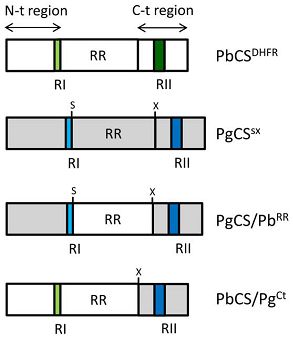| top of page |
| Details of the target gene |
| Gene Model of Rodent Parasite |
PBANKA_0403200
|
| Gene Model P. falciparum ortholog |
PF3D7_0304600
|
| Gene product | circumsporozoite (CS) protein |
| Gene product: Alternative name | CS; CSP |
| top of page |
| Details of the genetic modification |
| Short description of the mutation | Chimeric cs gene: N-terminal and repeat region from P. berghei and C-terminal from P.gallinaceum cs |
| Inducable system used | No |
| Short description of the conditional mutagenesis | Not available |
| Additional remarks inducable system |
|
| Type of plasmid/construct | Plasmid double cross-over |
| PlasmoGEM (Sanger) construct/vector used | No |
| Modified PlasmoGEM construct/vector used | No
|
| Plasmid/construct map |
|
| Plasmid/construct sequence |
|
| Restriction sites to linearize plasmid |
ApaI
|
| Selectable marker used to select the mutant parasite | tgdhfr |
| Promoter of the selectable marker | pbdhfr |
| Selection (positive) procedure | pyrimethamine |
| Selection (negative) procedure | No |
| Additional remarks genetic modification | Other integration events were also observed after transfection with the pPgCS/PbRR vector (RMgm-770), as a consequence of cross-over events that took place between sequences present in the internal part of the construct and the homologous sequences in the PbCS locus. This resulted in the generation of two further transgenic parasite lines, PbCS/PgCT (described here) and PbCSDHFR (not taken up in the RMgm database). PbCS/PgCT clones 3 and 6 originated from cross-over events at the 0.5 kb PbCS repeat region and the 3’ UTR sequence. The PbCS/PgCT parasite line generated therefore containes a chimeric CS gene where both the N-terminal sequence and the repeat region are from P. berghei, with a C-terminal sequence from P. gallinaceum |
| Additional remarks selection procedure | |
Primer information: Primers used for amplification of the target sequences  Primer information: Primers used for amplification of the target sequences 
| Sequence Primer 1 | |
| Additional information primer 1 | |
| Sequence Primer 2 | |
| Additional information primer 2 | |
| Sequence Primer 3 | |
| Additional information primer 3 | |
| Sequence Primer 4 | |
| Additional information primer 4 | |
| Sequence Primer 5 | |
| Additional information primer 5 | |
| Sequence Primer 6 | |
| Additional information primer 6 | |
|
|
| top of page |
 *RMgm-771
*RMgm-771 Mutated: Mutant parasite with a mutated gene
Mutated: Mutant parasite with a mutated gene


